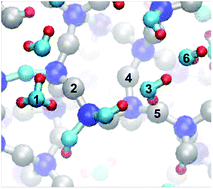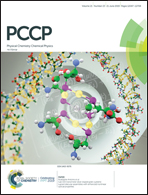Role of the hydrogen bond lifetimes and rotations at the water/amorphous silica interface on proton transport
Abstract
Using a highly robust and reactive all-atom potential, molecular dynamics computer simulations have been used to provide detailed analysis of the behavior of water and protons at a large-scale amorphous silica surface that offers the heterogeneity of surface sites and water/silica interactions. Structural data of the H–O distances as a function of distance from the glass surface showed variation in hydrogen bond (H-bond) lengths to second and third nearest oxygen neighbors that play an important role in H-bond lifetimes, rotations, and proton transfer, especially at the glass surface. The higher density and inherently closer average spacing between oxygens in the glass surface (2.6 Å) in comparison to that in water (2.8 Å) create a significantly different environment for H-bond lifetimes and proton transfers. Continuous H-bond lifetime autocorrelation functions for water H-bonded to the surface are considerably shorter than those of bulk water, whereas the intermittent lifetime autocorrelation functions are longer. Such results affect proton transfers that are over an order of magnitude higher at the surface than farther from the surface or in bulk water. However, most of these transfers are rattling events between the participating oxygens, one of which is the newly formed H3O+ ion adjacent to the interface. Such a H3O+ ion has an extremely low barrier to proton transfer back to the surface site in comparison to a H3O+ ion in bulk water. Nonetheless, the simulations showed that rotation of the H3O+ ion away from the initial transfer site allowed for structural diffusion of an excess proton away from the surface. Proton conduction from such rotations could be enhanced by external forces.



 Please wait while we load your content...
Please wait while we load your content...